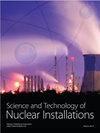高通量研究堆排热系统的概念
IF 0.9
4区 工程技术
Q3 NUCLEAR SCIENCE & TECHNOLOGY
引用次数: 0
摘要
在研究压水反应堆中实现高中子通量直接关系到冷却剂流经堆芯的强度和堆芯内的压力,这提供了更高的饱和温度和临界热流的余量。因此,池型反应堆实际上不可能提供很高的中子通量,特别是在堆芯冷却剂向下运动的情况下。同时,容器型研究堆(如SM-3和HFIR)使中子通量密度达到4 × 1015 n/(cm2 s)成为可能,但同时,如果排热系统发生违规,堆芯退化的风险变得相当高。提出的用于高通量反应堆设施的排热系统概念结合了从堆芯安全排热的可靠性提高和处理辐照电池的便利性,例如在同位素生产中。这个概念提供了一个加压容器中致密堆芯的位置,以及在反应堆池中容器周围放置一个中子反射器。通过不同的冷却剂强制循环系统对反应堆外壳内的堆芯和中子反射器内的辐照通道进行冷却。同时,在反应堆停堆时,打开自然循环阀后,可以利用反应堆池的水对堆芯和中子反射器进行安全放热。然而,即使在所有强制循环回路完全失效的情况下,从池表面蒸发的水也可以安全地从燃料组件和反射器单元中的辐照装置中除去余热。本文章由计算机程序翻译,如有差异,请以英文原文为准。
The Concept of the Heat Removal System of a High-Flux Research Reactor
Achieving high neutron fluxes in research pressurized water reactors is directly related to the intensity of the coolant flow through the core and the pressure in it, which provides an increased saturation temperature and a margin to critical heat flux. Therefore, it is practically impossible to provide very high neutron fluxes in pool-type reactors, especially in the case of downward movement of the coolant in the core. At the same time, vessel-type research reactors (for example, SM-3 and HFIR) make it possible to achieve neutron flux densities up to 4 × 1015 n/(cm2 s), but at the same time, the risks of core degradation in case of violations in the heat removal system become quite high. The proposed concept of a heat removal system for a high-flux reactor facility combines the increased reliability of safe heat removal from the core and the convenience of handling irradiation cells, for example, in the production of isotopes. The concept provides for the location of a compact core in a pressurized vessel and the placement of a neutron reflector around the vessel in the reactor pool. Cooling of the reactor core in the housing and the irradiation channels in the neutron reflector is carried out by different systems of forced circulation of the coolant. At the same time, at the shutdown reactor, after opening the natural circulation valves, safe heat removal from the reactor core and the neutron reflector can be carried out by the water of the reactor pool. However, even with a complete failure of all forced circulation circuits, the evaporation of water from the surface of the pool makes it possible to safely remove the residual heat from the fuel assemblies and from the irradiation devices in the cells of the reflector.
求助全文
通过发布文献求助,成功后即可免费获取论文全文。
去求助
来源期刊

Science and Technology of Nuclear Installations
NUCLEAR SCIENCE & TECHNOLOGY-
CiteScore
2.30
自引率
9.10%
发文量
51
审稿时长
4-8 weeks
期刊介绍:
Science and Technology of Nuclear Installations is an international scientific journal that aims to make available knowledge on issues related to the nuclear industry and to promote development in the area of nuclear sciences and technologies. The endeavor associated with the establishment and the growth of the journal is expected to lend support to the renaissance of nuclear technology in the world and especially in those countries where nuclear programs have not yet been developed.
 求助内容:
求助内容: 应助结果提醒方式:
应助结果提醒方式:


